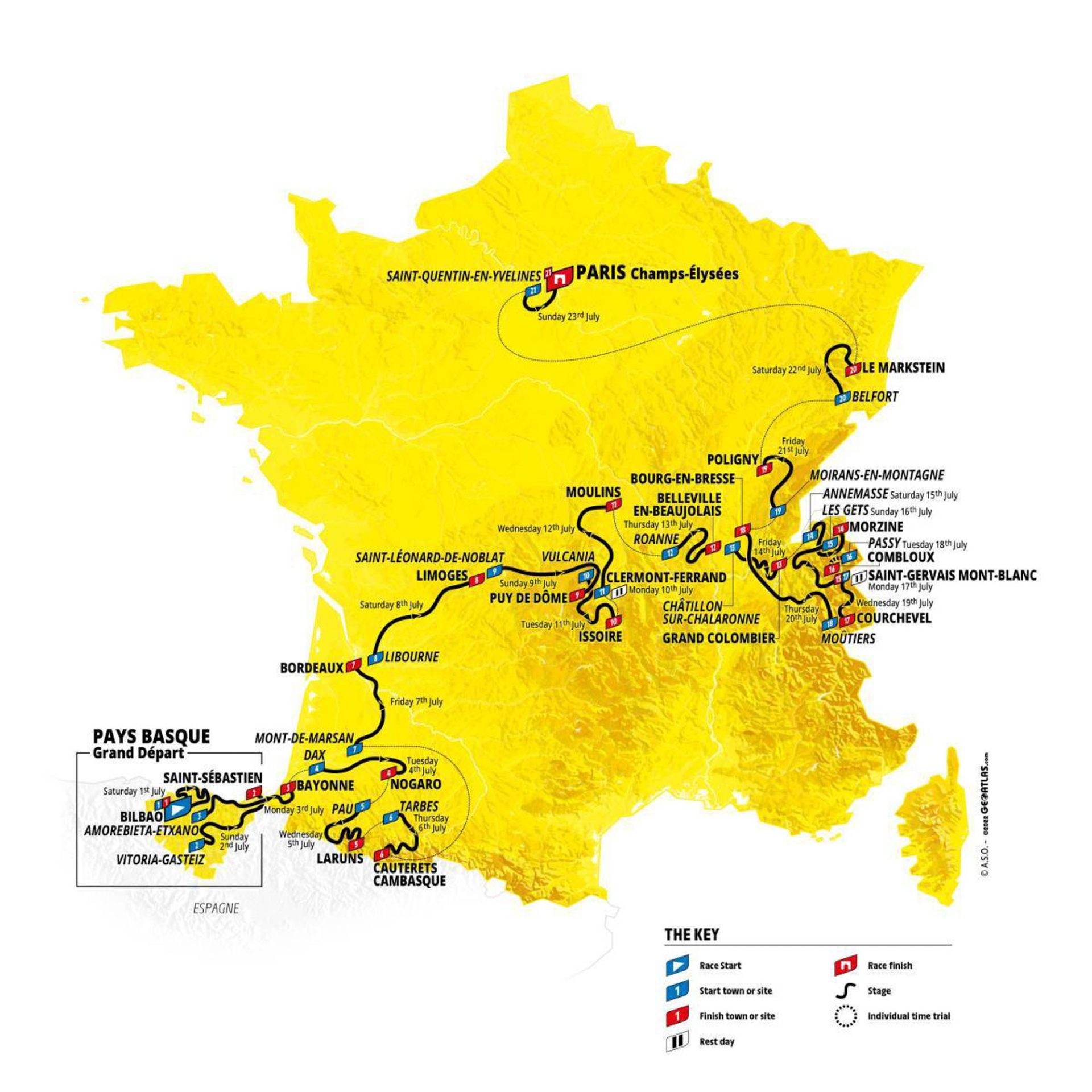We haven’t seen a Tour de France route quite like this one before. Not only because the host of the Grand Départ, the beautiful Basque city of Bilbao, has never hosted a Tour stage before, but because the overall direction and balance of the stages is unique in modern Tours de France.
It’s a difficult Tour, right from the start. The first week features more climbing than usual, much of it on the short, punchy ascents we know from races like the Tour of the Basque Country and Klasikoa San Sebastian. It’s a climber’s Tour, too, with only one 22 km time trial, which itself contains a difficult Category 2 climb. The 2023 Tour de France never goes more than two days without some sort of potential GC shakeup. That is no accident.
The route starts in northern Spain and heads in a mostly northeasterly direction from there, doubling back on itself multiple times and, quite unusually, camping for long periods in two different cities. We spend four days within shouting distance of Clermont-Ferrand in the middle of the country, and then sit again in the heart of the Alps for three days (four if you include the rest day in the middle) near the end of the race.
The hardest stage, on paper, is probably stage 17, which finishes on the new Tour favorite Col de la Loze, or 14, which has endless climbing. Stages 15, and 6 are in the same bracket. Monsters, each of them.
The Alps win out over the Pyrenees this year, at least in terms of total difficulty. But the race touches all five of France’s mountain ranges, and the days in the Massif Central, Vosges, and the Jura shouldn’t be ignored. In the Massif Central, a finish atop the volcano at Puy de Dôme contains some of the steepest kilometers of the whole race. In the Vosges, the final stage to Le Markstein has all the hallmarks of a GC trap. Its placement just a day before Paris could make it the most thrilling stage of the race.
Looking for Tour de France team rosters? We’re updating the eight-man lineups as they’re announced.
Jump to stage details:
• Stage 1: July 1 – Bilbao to Bilbao – 182 km
• Stage 2: July 2 – Vitoria-Gasteiz to Saint-Sébastien – 209 km
• Stage 3: July 3 – Amborebieta-Etxano to Bayonne – 185 km
• Stage 4: July 4 – Dax to Nogaro – 182 km
• Stage 5: July 5 – Pau to Laruns – 165 km
• Stage 6: July 6 – Tarbes to Cauterets-Cambasque – 145 km
• Stage 7: July 7 – Mont-De-Marsan to Bordeaux – 170 km
• Stage 8: July 8 – Libourne to Limoges – 201 km
• Stage 9: July 9 – Saint-Léonard-De-Noblat to Puy de Dôme – 184 km
• July 10 – Rest Day
• Stage 10: July 11 – Vulcania to Issoire – 167 km
• Stage 11: July 12 – Clermont-Ferrand to Moulins – 180 km
• Stage 12: July 13 – Roanne to Belleville-en-Beaujolais – 169km
• Stage 13: July 14 – Châtillon-Sur-Chalaronne to Grand Colombier – 138 km
• Stage 14: July 15 – Annemasse to Morzine Les Portes Du Soleil – 152 km
• Stage 15: July 16 – Les Gets to Saint-Gervais Mont Blanc – 180 km
• July 17 – Rest Day
• Stage 16: July 18 – Passy to Combloux – 22 km
• Stage 17: July 19 – Saint-Gervais Mont Blanc to Courchevel – 166 km
• Stage 18: July 20 – Moûtiers to Bourg-En-Bresse – 186 km
• Stage 19: July 21 – Moirans-en-Montagne to Poligny – 173 km
• Stage 20: July 22 – Belfort to Le Markstein Fellering – 133 km
• Stage 21: July 23 – Saint-Quentin-En-Yvelines to Champs-Élysées – 115 km
This route is … evenly loaded?
There’s been a fair amount of chatter about this Tour route being frontloaded. That isn’t wrong when you put the route in context of previous years, but it isn’t exactly right when you compare the first week to the second half of the race.
To aid in visualizing the route as a whole, we (subjectively) ranked every stage’s potential GC jeopardy on a scale of 1-10. One is a sprint stage. Ten is a crazy high mountain day with an uphill finish (there are no 10s in this year’s Tour). Hilly stages like those found in Bilbao in the first week all sit between four and six. They’re hard, and could see potential time gains, but they’re not high-mountain hard.
The result? What appears to be a very balanced route. Like anybody trying to build narrative, the Tour de France clearly doesn’t want to slow things down for too many days in a row. Thierry Gouvenou, who designs the Tour’s routes, peppered interesting and/or difficult stages throughout the race, all the way from the short, punchy climbs of stage 1 to the final climbing day to Le Markstein.
The race will feature a total of 30 climbs categorized 2 or higher. That’s seven more than last year, three more than 2021. They are spread quite evenly, as the above chart suggests. One in the Basque country, six in the Pyrenees, four in the Massif Central, one in the Jura, 13 in the Alps, and five in the Vosges.
GC favorites will have to be on their game from stage 1 to stage 20. That’s somewhat unusual. But it should make for a fantastic race.
Let’s take a look at the profiles, key moments, and defining features of each stage of the 2023 Tour de France.
If you prefer to listen, this week’s podcast is a detailed breakdown of all 21 stages.
Stage 1: Bilbao to Bilbao – 182 km
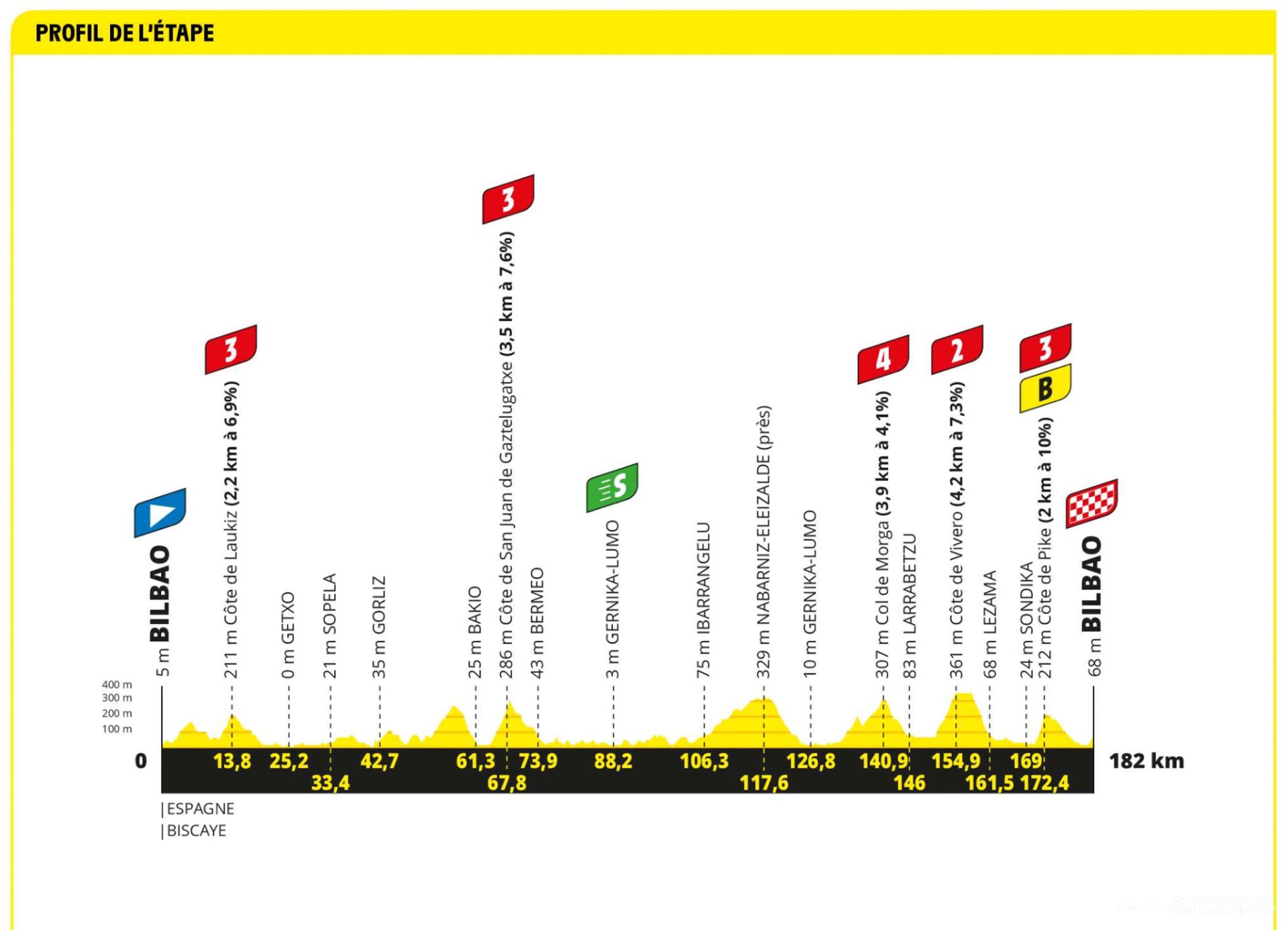

Date: Saturday July 1, 2023
Stage type: Hilly
Potential winners: Puncheurs or possibly a GC man. Julian Alaphilippe, Tadej Pogačar, Jonas Vingegaard. Or maybe even Wout van Aert or Mathieu van der Poel.
What to watch for: Jonas Vingegaard won a similar stage of the Dauphiné in June. He seems to have been working on his punch. Will he take advantage?
Stage 1 summary: No easing into this Tour de France. The very first stage takes in 3,300 meters (10,000 feet) of climbing in a large loop starting and finishing in Bilbao, in the heart of the cycling-mad Basque region. The final climb, the last in a series of four in the last 60 km, is the Côte de Pike, a nasty kicker that averages 10% over 2 km. To further increase the importance of that climb, there are bonus seconds (8-5-2) available for the first three riders over the top.
It’s mean. It will split things up. The first yellow jersey (and all the rest of the jerseys) is on the line.


It’s also taking place in one of cycling’s traditional heartlands, and specifically a region that has produced climbers by the bucketload. From 1994 to 2013, the sight of the distinctive orange jerseys of the team built around the Euskadi Cycling Foundation flocking to the front meant the real climbing was about to start. Names like Unai Etxeberria and Iban Mayo, and later Mikel Landa and the Izaguirre brothers, all performed their acts of antigravity while racing in that bright orange. The team is now rebuilding, currently with ProTeam status, with the goal of returning to the Tour de France.
Stage 2: Vitoria-Gasteiz to Saint-Sébastien – 209 km


Date: Sunday July 2, 2023
Stage type: Hilly
Potential winners: Bauke Mollema loves the Jaizkibel climb. So do riders like Mathieu van der Poel, Matej Mohoric, and EF’s Neilson Powless.
What to watch for: San Sebastian often comes down to a small group sprint and that’s the likely outcome of this stage, too.
Stage 2 summary: This stage finishes 500 meters lower than it starts, but don’t let that fool you.
The decisive climb from Donostia San Sebastian Klasikoa, a post-Tour one-day race in the region, is placed just 20 km from the finish of stage 2. The slopes of the Jaizkibel, 8 km long and averaging 5.1%, with a final 4 km at 7%, have decided most editions of that race.


The descent down the backside and into the finish could prove just as decisive in stage 2 of the Tour de France.
Stage 3: Amorebieta-Etxano to Bayonne – 185 km


Date: Monday July 3, 2023
Stage type: Flat
Potential winners: Mark Cavendish, Fabio Jakobsen, Jasper Philipsen
What to watch for: Potential echelons along the coast.
Stage summary: A couple early and relatively easy climbs shouldn’t spoil the day for sprinters, but the run-in to Bayonne isn’t exactly straightforward so a break may think it stands a small chance of pulling one over on the peloton. They’ll certainly try. Plus much of the route runs along the coast, making crosswinds and echelons a possibility.
Still, a sprint is most likely for the stage that takes the race back to France.
Stage 4: Dax to Nogaro – 182 km
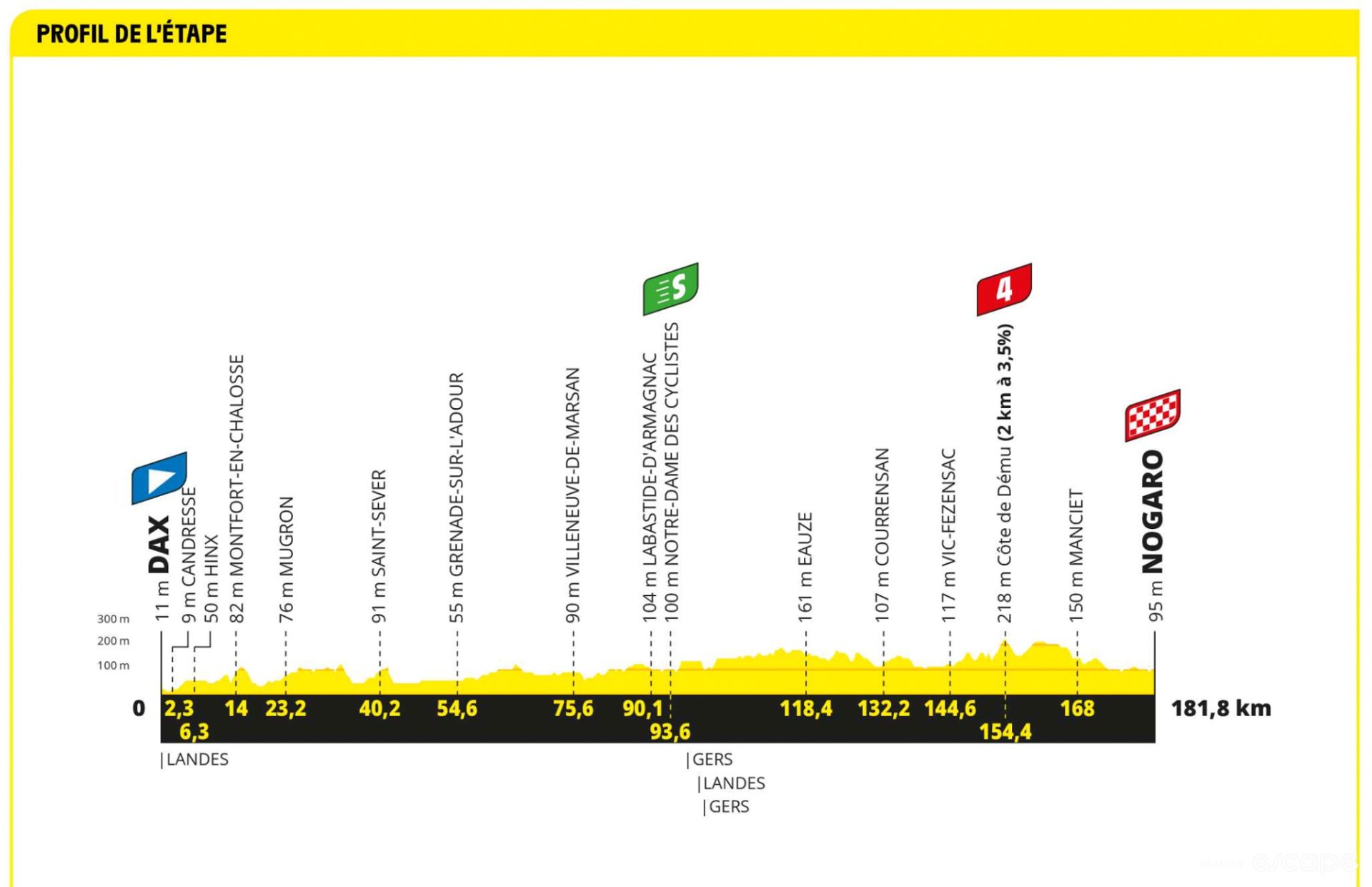

Date: Tuesday July 4, 2023
Stage type: Flat
Potential winners: Biniam Girmay, Jasper Philipsen, Dylan Groenewegen, Mads Pedersen, Caleb Ewan
What to watch for: Auto racing circuits are always a bit chaotic, and usually harder than they look. This one is no different.
Stage summary: This is the second in a pair of flat stages intended to give the peloton a small breather before the Pyrenees, very much designed for a sprint finish. It finishes on the Nogaro motor racing circuit, including an 800 meter straight into the finish line.
That might seem to have bunch sprint written all over it, and that is a pretty safe bet. But the top sprinters, and more specifically their teams, may have a difficult time.
The last time Nogaro was used in a pro race was the 2017 Route du Sud when the stage was won by EF’s Tom Scully, who is not a pure sprinter. He was part of a 12-rider breakaway that was caught, but not passed, just as it crossed the finish line. The top sprinters on that stage were Elia Viviani and Bryan Coquard, in seventh and eighth respectively.
Motor racing tracks are full of corners that make it difficult to mount a real chase. If the sprint teams leave it too late, they could get caught out again.
Stage 5: Pau to Laruns – 165 km


Date: Wednesday July 5, 2023
Stage type: High Mountains – Pyrenees
Potential winners: Pello Bilbao, Giulio Ciccone
What to watch for: The fight for the break will be fierce.
Stage summary: The first true mountain day, though without a mountain-top finish.
Stage 5 tackles the hors-categorie Col du Soudet at its halfway mark, climbing 15.1 km at 7%. It’s a climb that’s unlikely to see GC fireworks but the day’s breakaway, which could be large given the high likelihood of survival for any breakaway group, will seek to shed some of its members.
The category 3 Col d’Ichère punctuates the second half of the stage before the final test: the category 1 Col de Marie Blanque, 9.2 km at 7.6%. That sounds hard, right? It’s even harder. The last 4.5 km average over 10%.
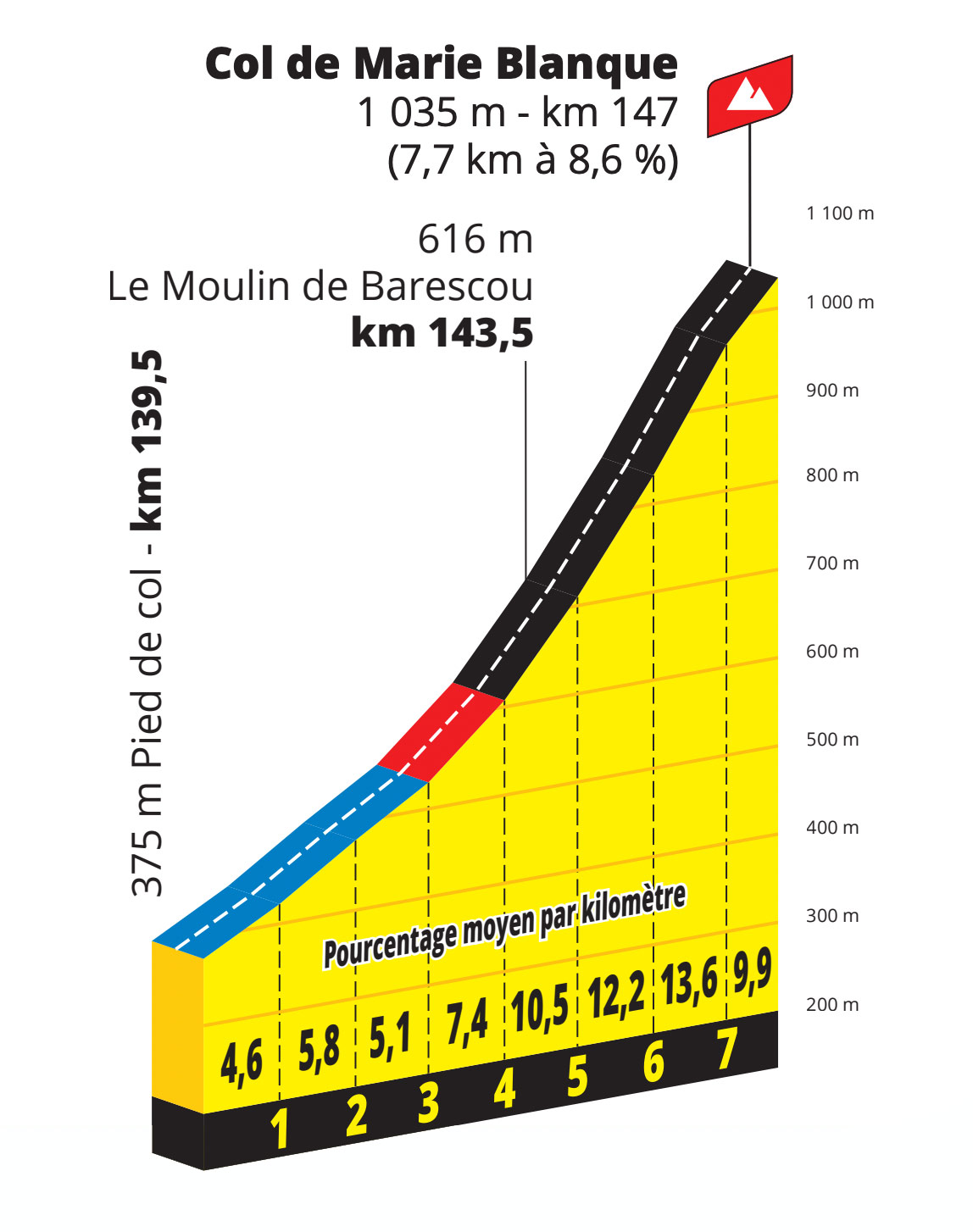

The distance from the bottom of the final descent to the finish line is a bit too far for any real GC moves to stick, but expect a high pace to be set on the slopes of the Marie Blanque. It’s likely some B-level GC contenders lose contact and struggle to come back.
Stage 6: Tarbes to Cauterets-Cambasque – 145 km
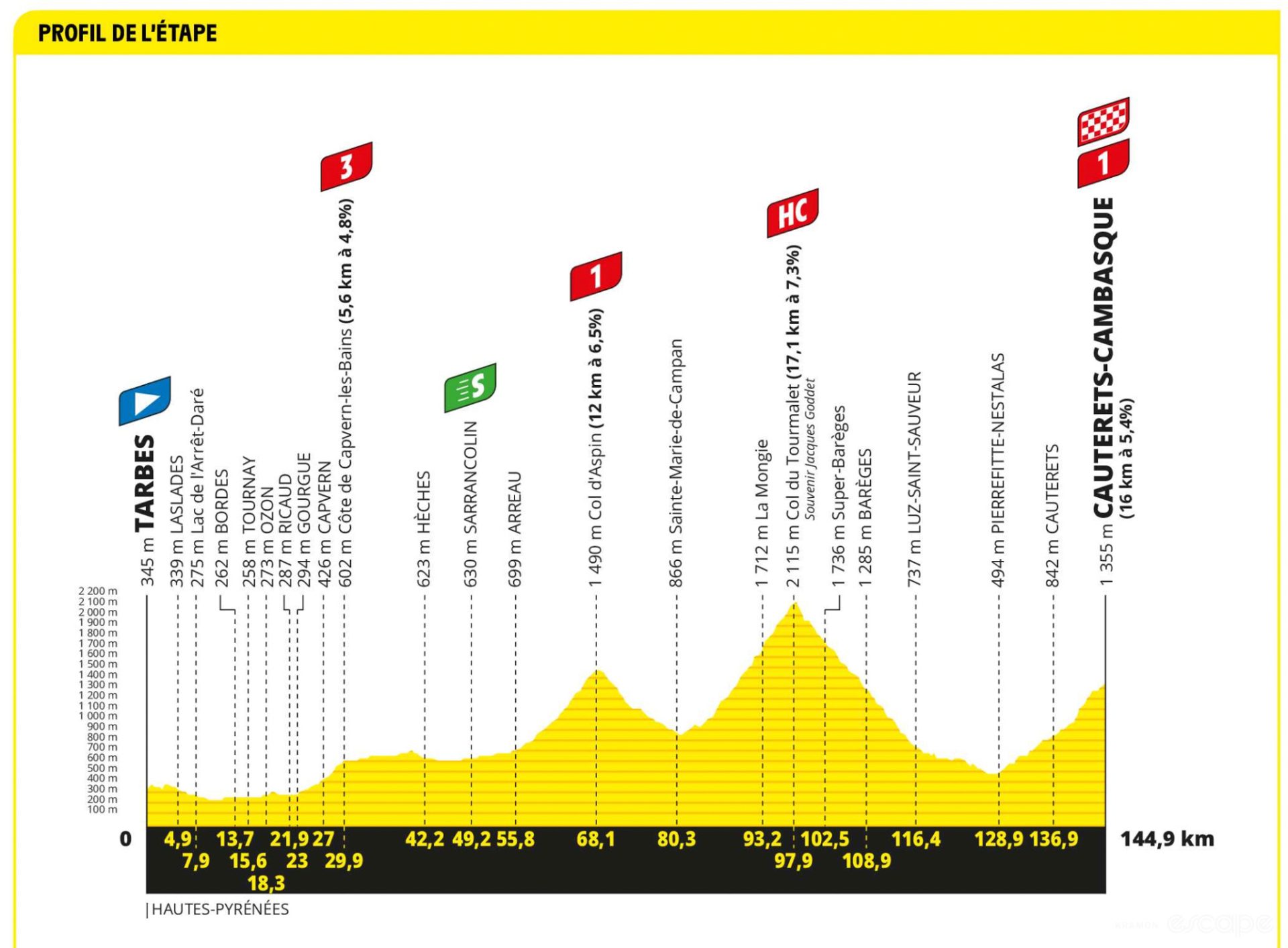

Date: Thursday July 6, 2023
Stage type: High Mountains – Pyrenees
Potential winners: Tadej Pogačar, Jonas Vingegaard, Mattias Skjelmose, Adam Yates
What to watch for: Which GC team takes control on the Tourmalet, as that will indicate confidence
Stage summary: Finally, the first big uphill finish of the 2023 Tour de France.
A short, sharp stage to end a two-day stint in the Pyrenees, this stage first tackles the Col d’Aspin, 12 km at 6.6%, then the fearsome Col du Tourmalet, 17.2 km at 7.3%. After a long descent off the Tourmalet, the race turns back to the south and climbs up to the finish in Cauterets.
The 15 km finish climb averages only 5.3% but has a 2 km section at kilometers 13 and 14 that average about 10%. If anybody goes, it will be here.
Stage 7: Mont-De-Marsan to Bordeaux – 170 km


Date: Friday July 7, 2023
Stage type: Flat
Potential winners: All the sprinters
What to watch for: An attempt to distance the pure sprinters on the only category 4 climb
Stage summary: Flat. Flat flat. Flatty flat flat.
The goal of this stage is simple: Get out of the Pyrenees, get up to Bordeaux so we can all have a nice glass of wine and celebrate … Mark Cavendish’s record-breaking stage win? It only seems right.
Stage 8: Libourne to Limoges – 201 km
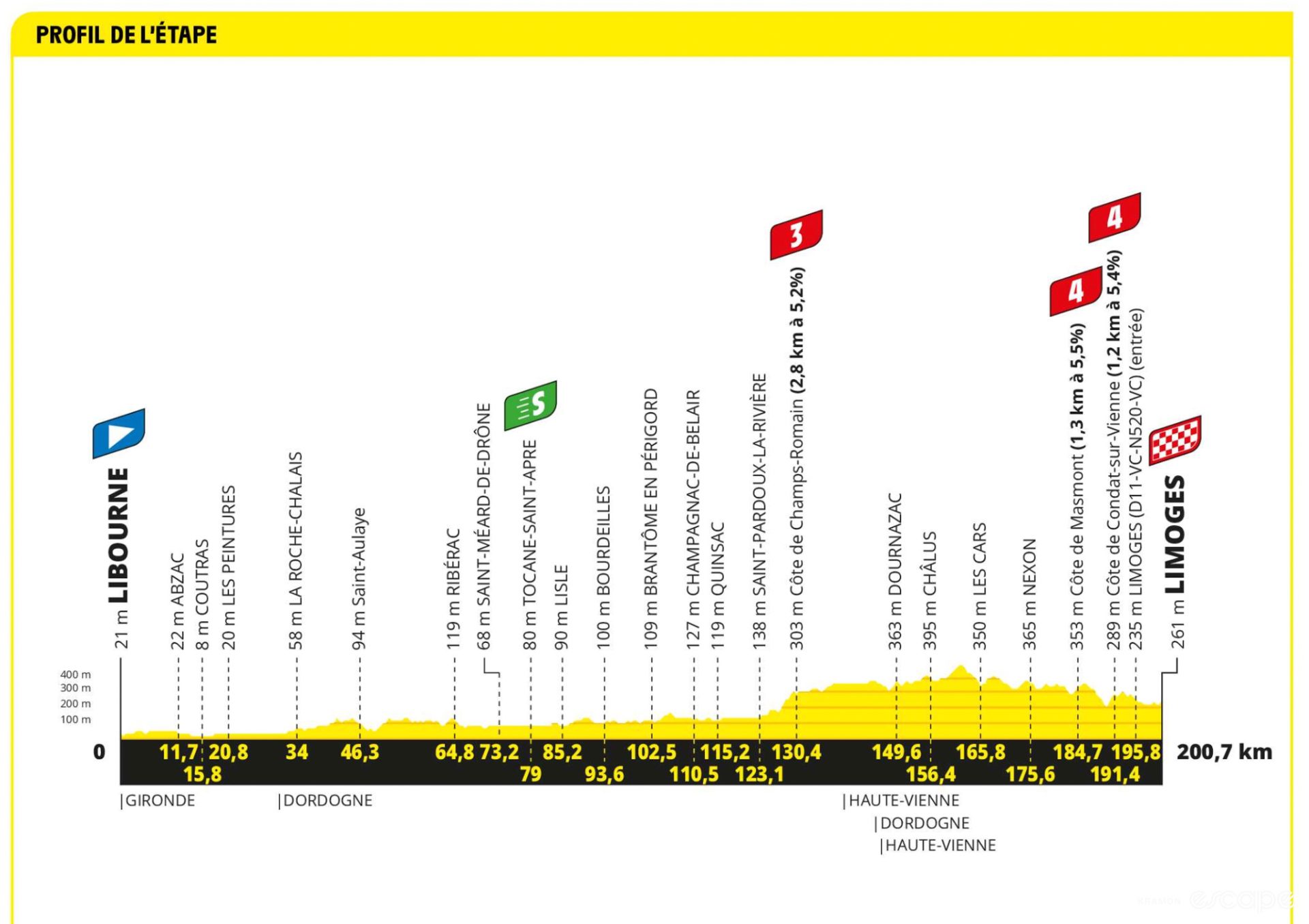

Date: July 8, 2023
Stage type: Mostly flat, punchy uphill finish.
Potential winners: Mads Pedersen, Wout van Aert, or Fred Wright from a break
What to watch for: Pure sprinters will console themselves by going for the green jersey points 80 km in.
Stage summary: The key route feature of stage 8 is the 2.8 km, 4.8% climb up to the finish line.
Limoges is traditionally a sprint finish town. The last time the race finished here, Bryan Coquard came as close as he ever has to a Tour stage win, losing a photo finish to one Marcel Kittel. This year, the pure sprinters will have a difficult time contesting.
First, there are the three categorized climbs (a cat 3 then two cat 4s) in the last 70 km. But that shouldn’t break things up too much.
This is a classic peak-era Peter Sagan finish, or more recently a Wout van Aert finish. It’s the type of stage that could be incredibly important for the green jersey competition. The pure sprinters will want to try to nab a few points, even if they can’t beat Van Aert. Other more well-rounded fast men like Mads Pedersen will be licking their lips.
Stage 9: Saint-Léonard-De-Noblat to Puy de Dôme – 184 km
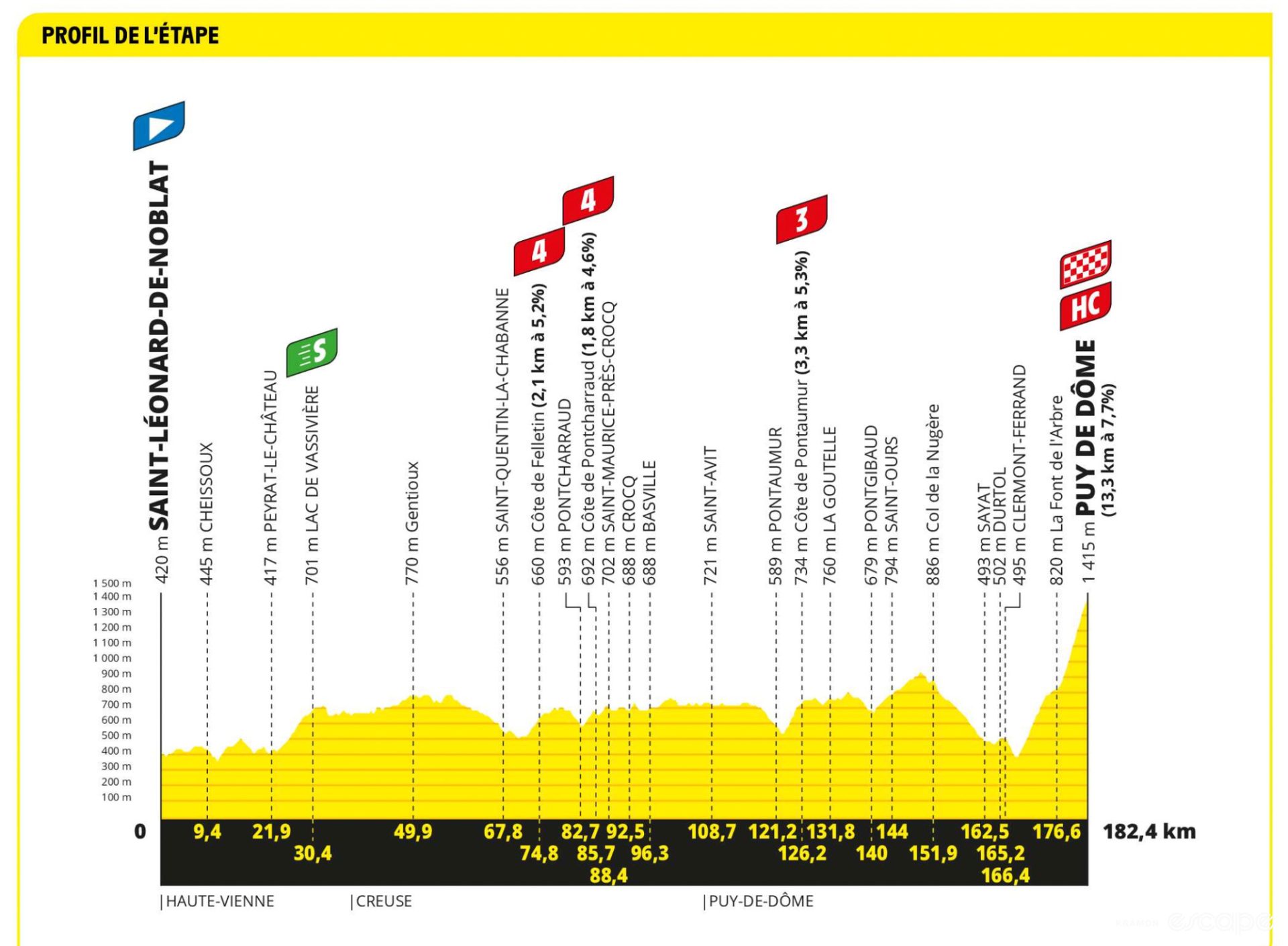

Date: July 9, 2023
Stage type: Mountain
Potential winners: Much depends on the breakway, let’s say Rigoberto Uran for old time’s sake
What to watch for: Superb volcano-related puns in Escape Collective headlines.
Stage summary: The last 4 km of this stage average over 11%. Before that, the climb to Puy de Dôme sits at a measly 6-7%.
This is a hard, potentially explosive stage, with one of the most difficult finishes of the entire Tour de France. Puy de Dôme is an ancient volcano and those final 4 km circle the top like some kind of real life Zwift volcano hell route (minus any actual lava).
The climb was the home of one of the Tour’s iconic duels. Raymond Poulidor (grandfather of Mathieu van der Poel) and Jacques Anquetil battled up it on stage 20 of the 1964 Tour de France, a race that had seen the two crack, recover, swap the lead, and then finally battle shoulder to shoulder on Puy de Dôme. Poulidor won the day but it wasn’t enough to overhaul Anquetil in the overall. It was probably the closest the “eternal second” came to winning the Tour.
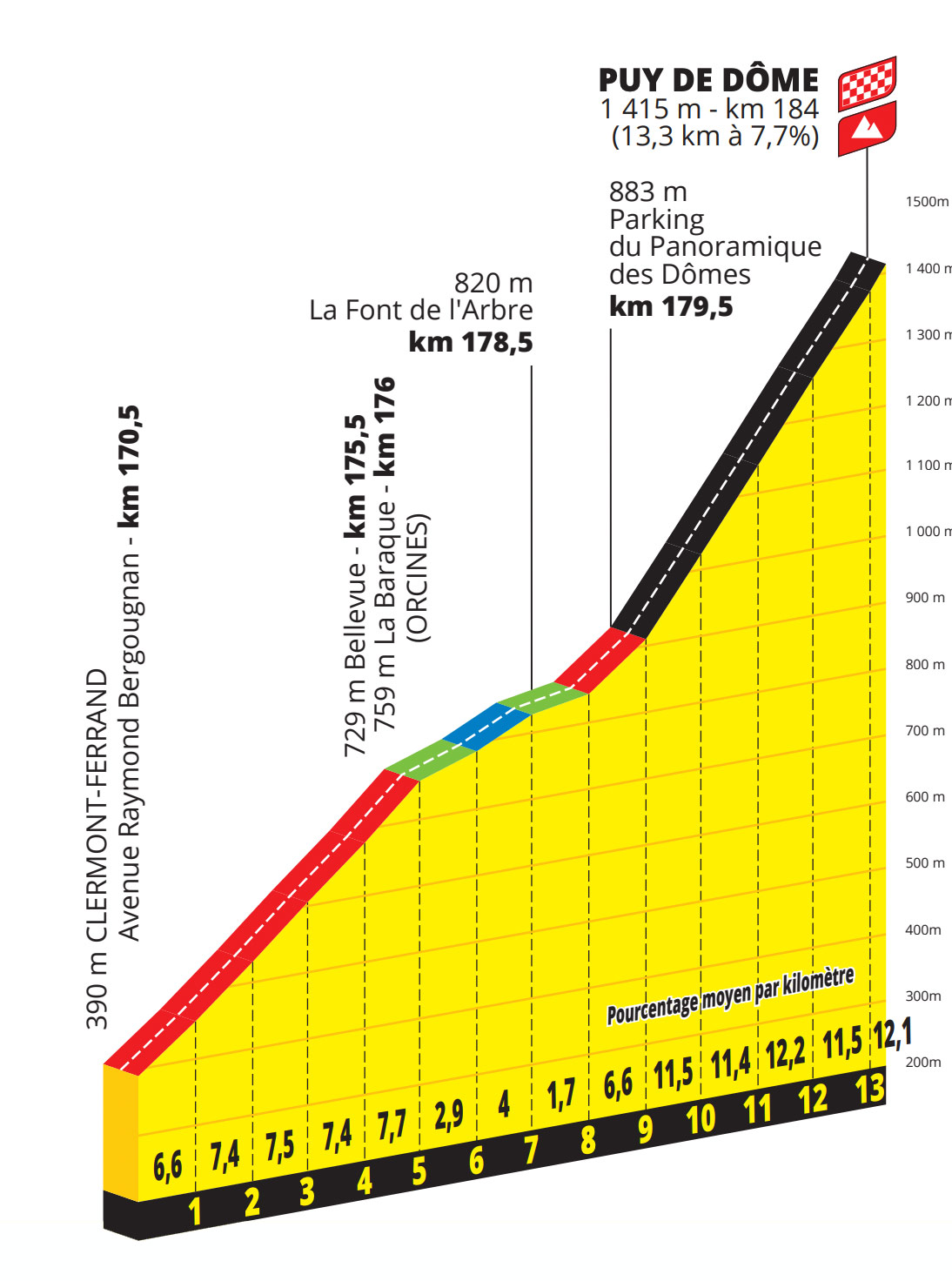

The stage as a whole is not as difficult as what is coming in the Alps. A string of category 3 and 4 climbs will do little to break up the bunch. It should play out somewhat similar to last year’s Planche des Belles Filles stage, which was similarly flat in the leadup to the final climb. After a few hours of cruising, Puy de Dôme will erupt into a half-hour power test.
July 10 – Rest day
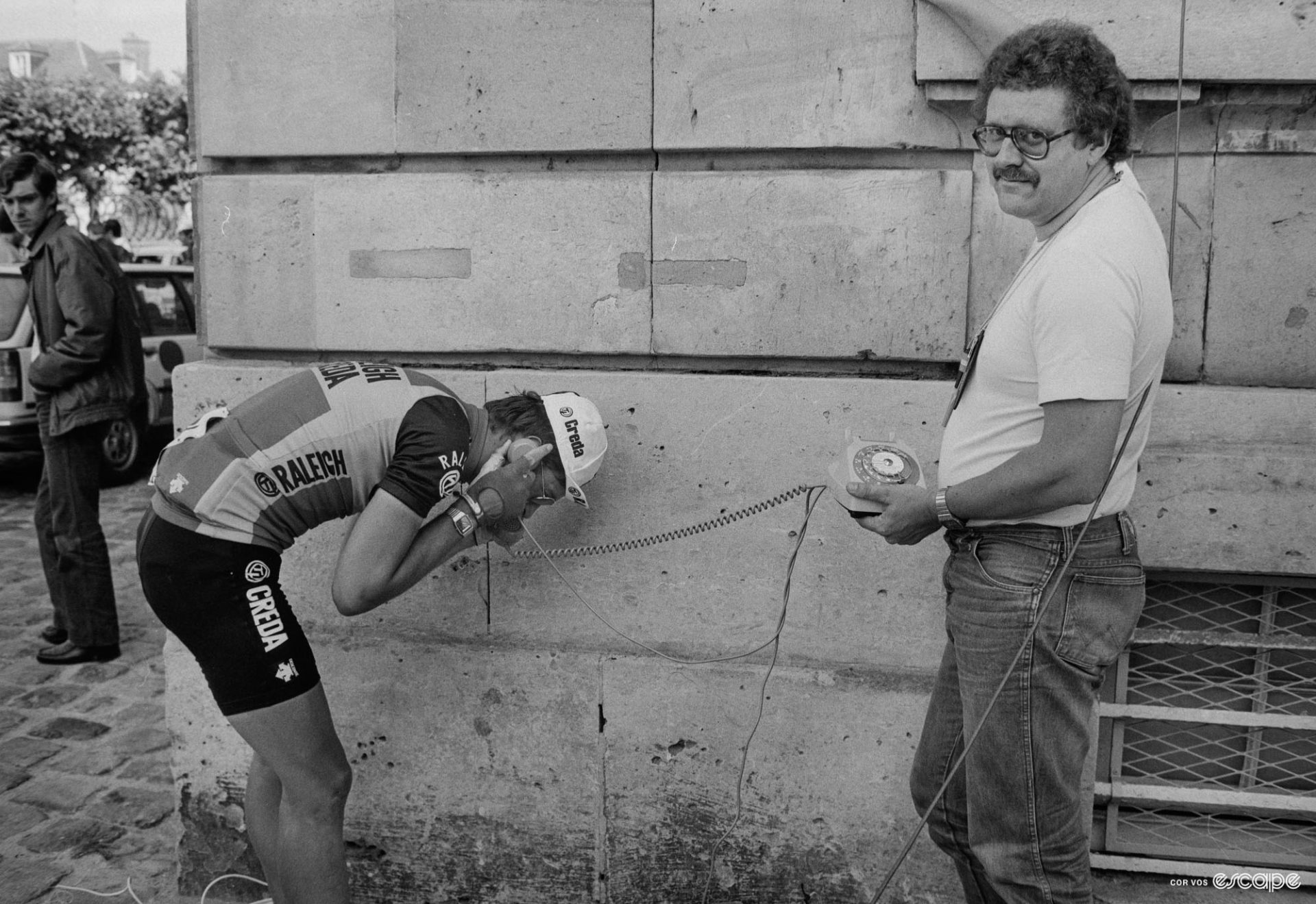

Stage 10: Vulcania to Issoire – 167 km


Date: July 11, 2023
Stage type: Hilly for the breakaway artists.
Potential winners: Toms Skujiņš
What to watch for: Riders looking to chase the polka dot jersey will want to be in this break
Stage summary: Rarely has a stage been so perfectly crafted for a breakaway as this one.
The peloton will spin out its rest day legs as a breakaway group fights it out up front, racing across five categorized climbs before a mostly downhill run-in to Issoire. That front group will be full of hitters thanks to the string of early climbs that make the breakway selection particularly difficult.
Stage 11: Clermont-Ferrand to Moulins – 180 km


Date: July 12, 2023
Stage type: Flat
Potential winners: Biniam Girmay, Jasper Philipsen
What to watch for: A mis-timed chase
Stage summary: Clermont-Ferrand is the home of Michelin tires and that is by far the most interesting thing about this stage.
Unless! Perhaps the peloton mistimes its chase on the undulating, semi-complicated run-in to Moulins. Breakaways have been surviving with increasing frequency in the last few seasons and this is the sort of stage where some strong rouleurs may try to pull off a coup.
But, let’s be honest, it’ll probably be a sprint.
Stage 12: Roanne to Belleville-en-Beaujolais – 169 km
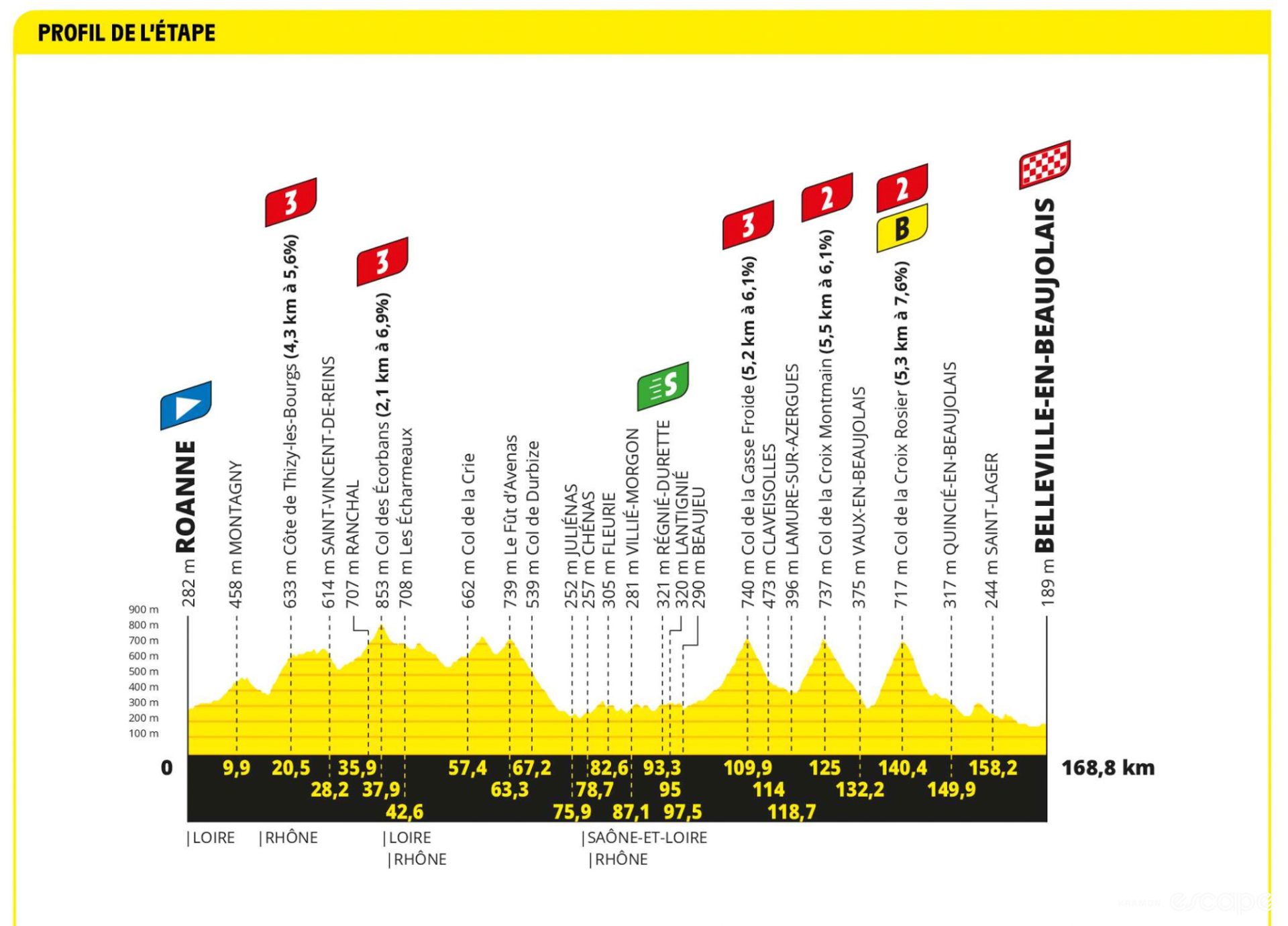

Date: July 13, 2023
Stage type: Hilly
Potential winners: Breakaway artists who can climb. Perhaps Neilson Powless or Matej Mohorič
What to watch for: The sprint points that come after two category 3 climbs will be tantalizing to any of the more-versatile sprinters. Could we see one try to jump in the breakaway, like Peter Sagan used to do?
Stage summary: Deep in one of France’s iconic wine regions, this stage seems primed for another successful breakaway. The two category 3 climbs in the first 40 km will ensure that the break is strong. Of the two back-to-back category 2 climbs in the latter third of the stage, the Col de la Croix Rosier is the more difficult, averaging 7.6% over 5.3 km. Expect it to be the final launch pad for either a solo winner, or a small group that splits off the day’s main breakaway.
Stage 13: Châtillon-Sur-Chalaronne to Grand Colombier – 138 km


Date: July 14, 2023
Stage type: Mountain
Potential winners: Jonas Vingegaard, Tadej Pogačar, anybody French
What to watch for: It’s Bastille Day! The French riders will of course want this one. Can David Gaudu pull one over on the rest?
Stage summary: Tour organizers have been keen on this sort of stage as of late. There isn’t much to separate the peloton ahead of the final test, an hors categorie slog up the 17.4 km Grand Colombier. That means tactics won’t really play a part in this stage. It’s a power test for the GC favorites.
There is a lump of a climb in the Col de la Lèbe before the Colombier, but after a short steep section early on it levels out and shouldn’t present any problems for even half-decent climbers.


The Grand Colombier itself is a monster. The length means there’s no hiding; a bad day could be catastrophic. The climb stair-steps a bit, with three distinct difficult sections. The second kilometer of the climb, 15 km from the finish, averages over 10%. Then kilometers 5-7 sit over 11%. Kilometers 10-12, with just 5 km to go, offer a final opportunity, sitting around 9.5%.
At this point, wind will play a part. The climb turns to the north for its final, flatter kilometers. If riders face a headwind, the top favorites will be less likely to go for it on that last steep section. If they have a tailwind, out of the south, we could see attacks fly with about 5 km to go.
Stage 14: Annemasse to Morzine Les Portes Du Soleil – 152 km
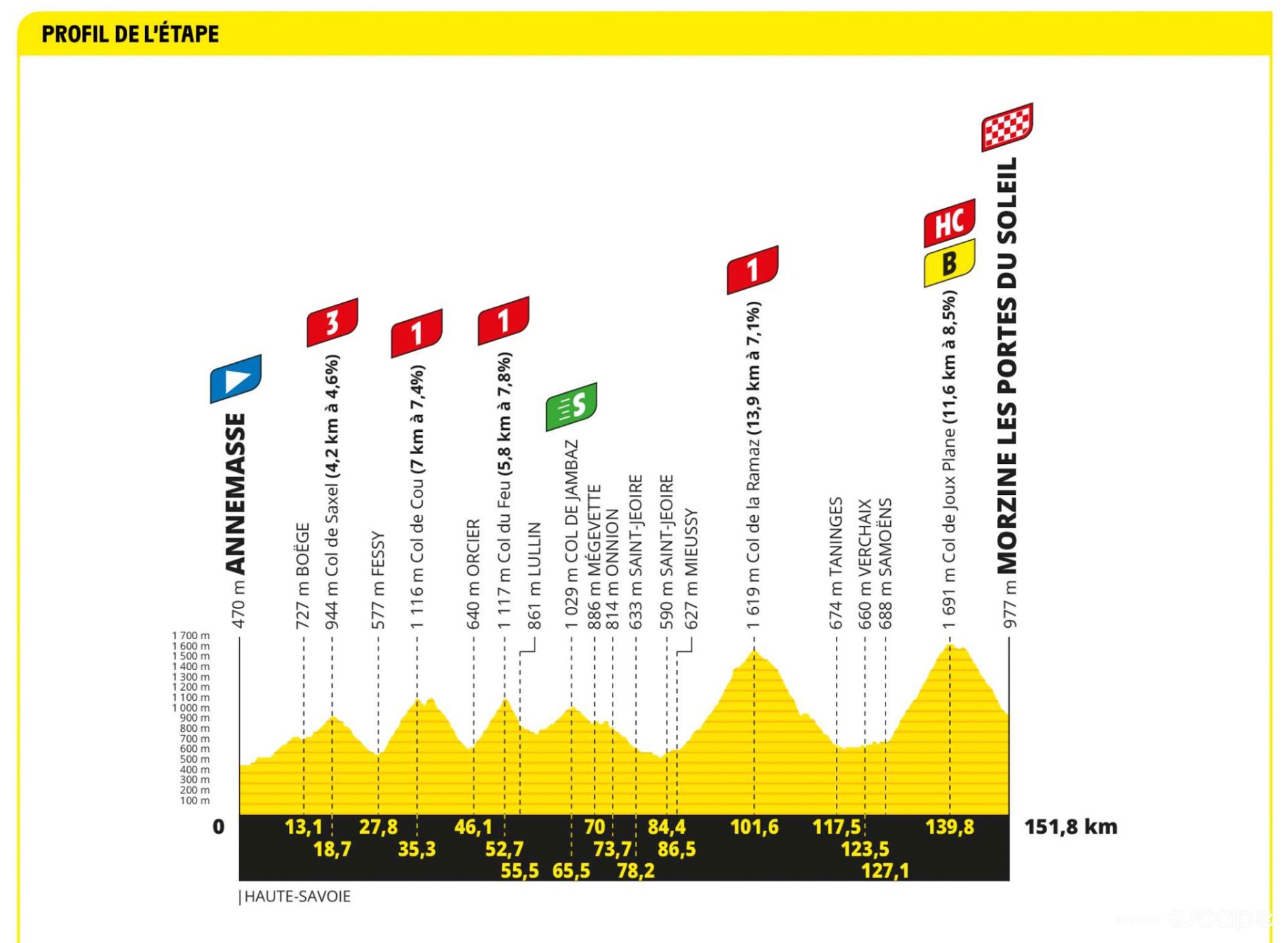

Date: July 15, 2023
Stage type: Mountains
Potential winners: A climber who can descend, like Giulio Ciccone or Tom Pidcock
What to watch for: Aurélien Paret-Peintre is from the start town of Annemasse and is likely to try to slide into the break.
Stage summary: The Joux Plane has been described as the nastiest climb in the Alps. Others have more notoriety, but few, if any, are actually harder. It was host to a famous Marco Pantani win in 1997 and, of course, the final climb in Floyd Landis’ unbelievable (and unnatural) solo, 120 km ride back into the yellow jersey in 2006. It has often flown under the radar but has a history of turning the Tour on its head.
Starting near the Swiss border before winding its way into the heart of the Alps, this latter half of the stage is nearly identical to the difficult day won by Ion Izaguirre in 2016. That stage also finished with the Col de la Ramaz and Col de Joux Plane before descending into Morzine, and we saw a large and star-studded breakaway ride clear before duking it out on the Joux Plane itself.


Behind, Chris Froome and his Team Sky train trundled along and kept their iron grip on the yellow jersey.
Could we see the same? It’s likely. The early climbs are good breakaway formation territory, and then the strongest climbers of that group will battle for the stage win. Behind, the GC men will have to be careful on Joux Plane and even more careful on the descent off its backside into the finish.
The descent is fast and dangerous, most because it’s unpredictable. The corners are often blind. What lies around the next bend? A sweeping, no-brakes flier or a nasty, decreasing radius corner? Riders will have to be on their game. Legend has it Sean Kelly once hit 124 km/h on this descent.
Stage 15: Les Gets Les Portes Du Soleil to Saint-Gervais Mont Blanc – 180 km
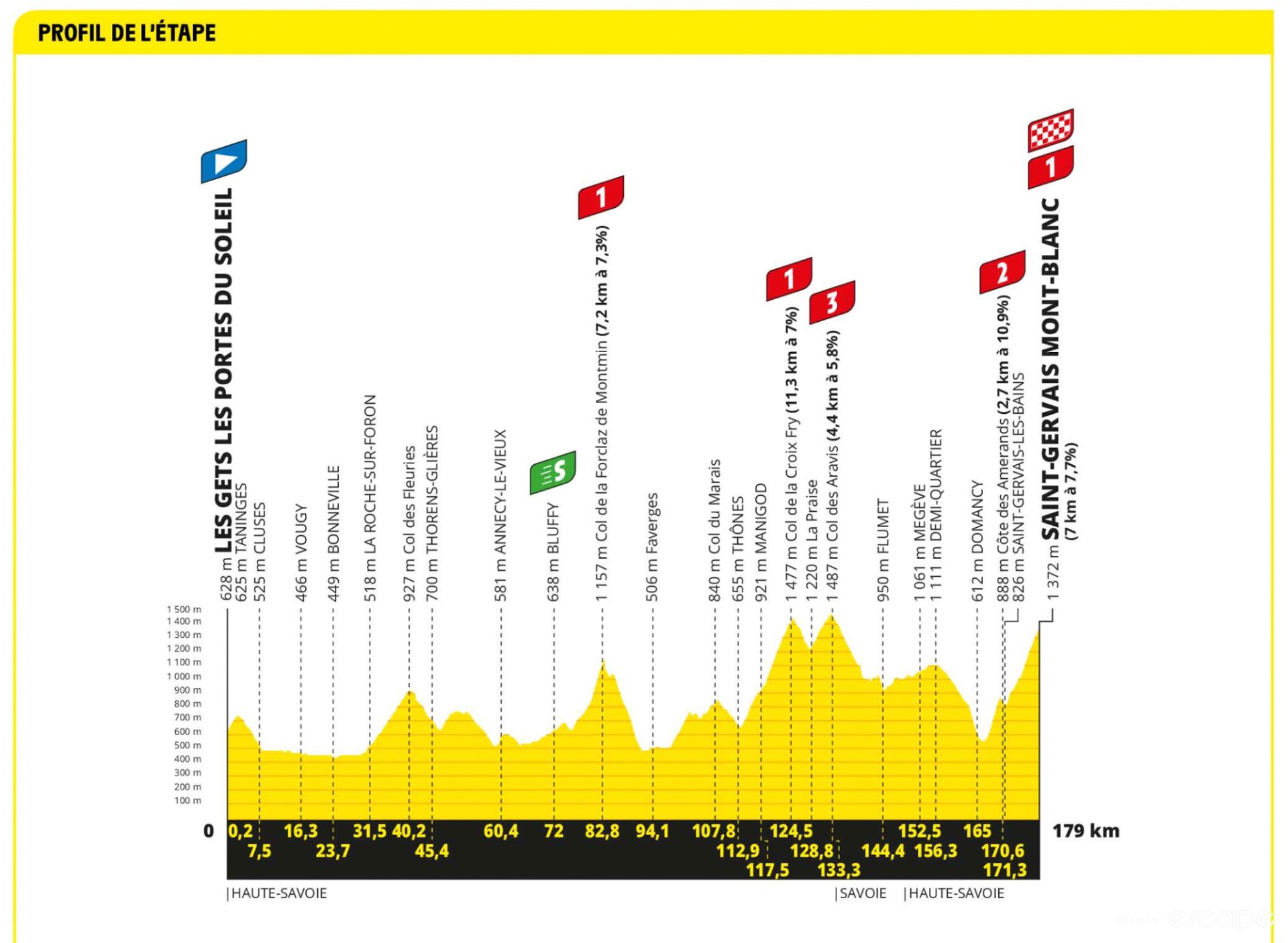

Date: July 16, 2023
Stage type: Mountain
Potential winners: GC favorites, Tadej Pogačar and Jonas Vingegaard
What to watch for: Small gaps could hold on this stage with few flat sections
Stage summary: A fitting cap to an incredibly difficult few days in the Alps. This stage takes in five categorized climbs (though the cat 2 and HC at the end are really one climb with a very short descent between them) and has some sneaky difficult moments long before the finish.
The Col de la Forclaz Montmin, ridden from the wider but steeper north side, is 90 kilometers from the finish and looks like a potential springboard. If a last-ditch, long-range attack were needed by one of the contenders, this might be the place to do it. The front side is steep, over 10% for its latter half. Crucially, the descent is narrow, no more than one lane in places. A few seconds over the top and a bit of daredevil descending could see somebody go free.


The finale, while technically two climbs, is effectively just one. Waking tired legs up after a long descent near the end of a stage can be difficult, which means the 16% grades at the base of the Amerands could be a make-or-break moment for any GC favorite. Have a bad moment there and there isn’t much time to come back on the 7% average grade up Bettex to Saint-Gervais Mont-Blanc.
July 17 – Rest day


Stage 16: Passy to Combloux individual time trial – 22 km
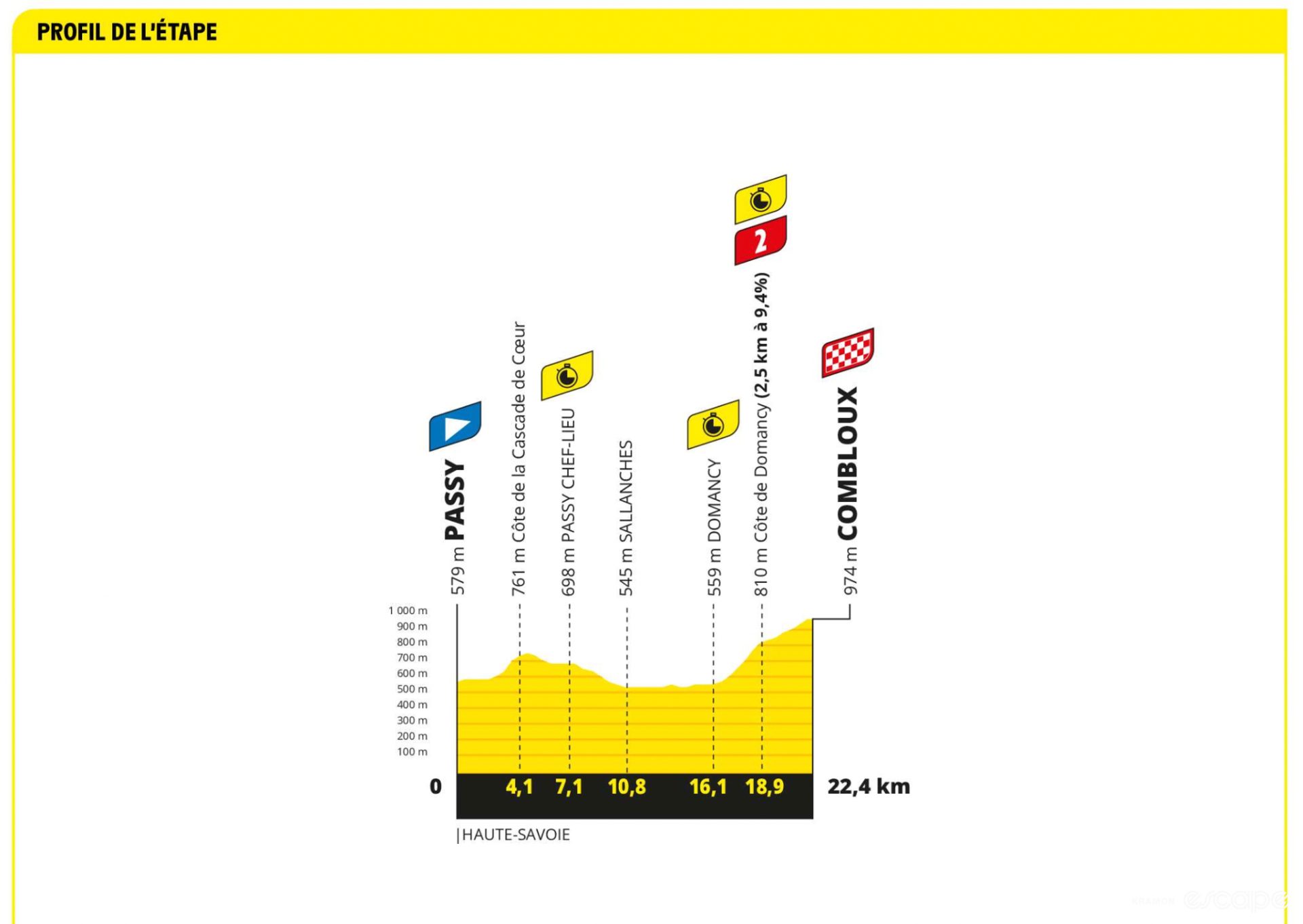

Date: July 18, 2023
Stage type: Individual time trial
Potential winners: Wout van Aert, Jonas Vingegaard, Tadej Pogačar
What to watch for: Rest days do odd things to some riders. Will any favorites suffer rest-day legs?
Stage summary: A category 2 climb defines this short but crucial time trial.
The Tour marks the “top” of the climb in Domancy, just 2.5 kilometers from the bottom. Those early kilometers are indeed the steepest, averaging 9.4%, but the climb doesn’t stop there. It keeps going for another 4 km. The total climb is 6.3 km at 6.6% average.
Three GC stages remain. This time trial, then two more days in the mountains. A bad day is not an option.
Stage 17: Saint-Gervais Mont Blanc to Courchevel – 166 km


Date: July 19, 2023
Stage type: Mountain
Potential winners: It seems unlikely a break will survive the GC onslaught, so one of the riders going for yellow
What to watch for: If the fight for yellow is still close, the bonus seconds on top of Col de la Loze could come into play.
Stage summary: Four categorized climbs and the narrow, twisty bike path up Col de la Loze define this final day in the Alps. A small descent means this isn’t technically an uphill finish, but that descent is short enough that any time gaps over the top of Col de la Loze are likely to stick until the finish line.


Stage 17 covers more than 5,000 m (16,400 ft) of climbing. The final three kilometers of the Col de la Loze are the most difficult, hovering around 10%. After that, a 6.5 km descent into Courchevel is capped by a short, incredibly steep (18%) kick up to the altiport.
Stage 18: Moûtiers to Bourg-En-Bresse – 186 km
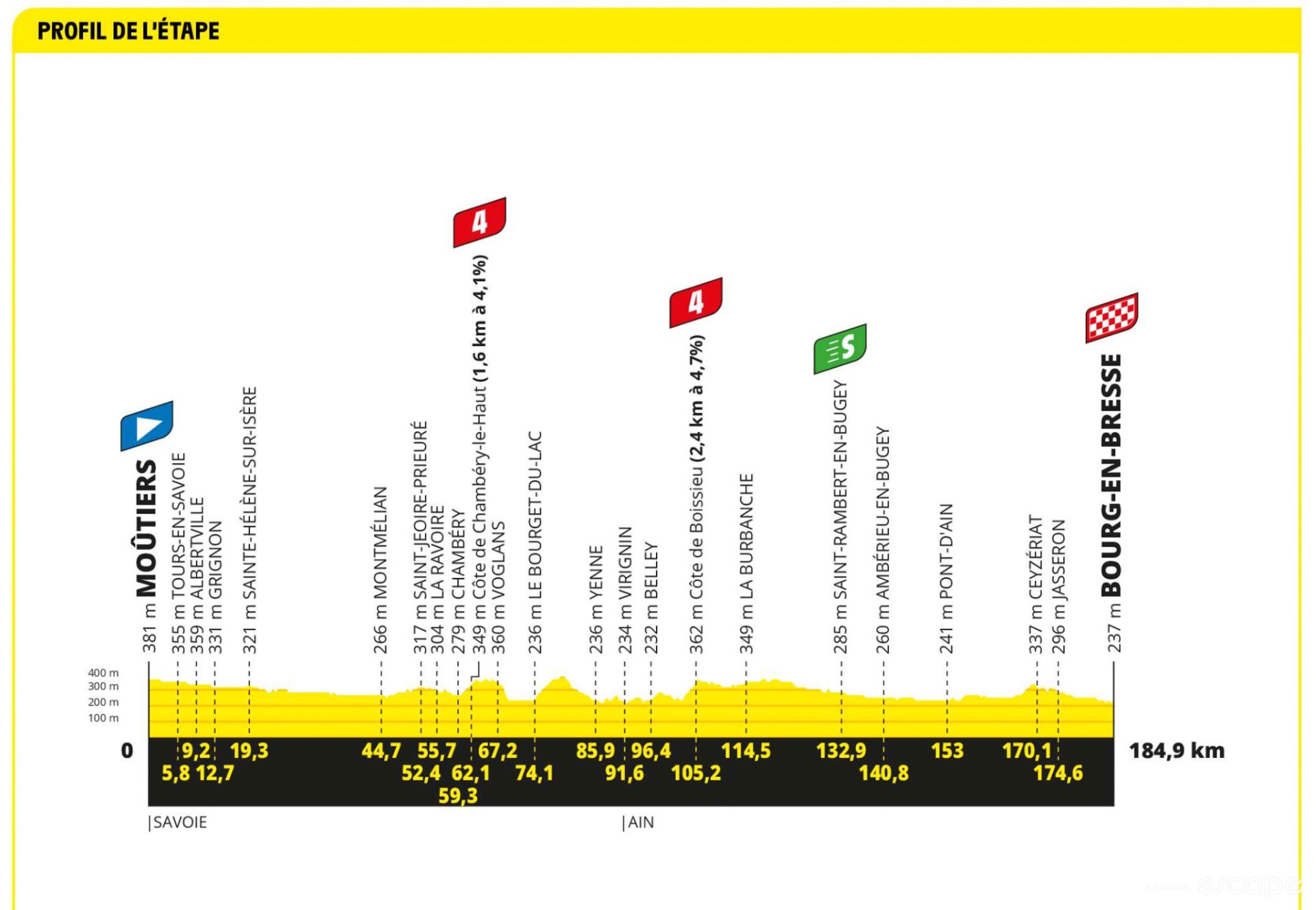

Date: July 20, 2023
Stage type: Flat
Potential winners: Whatever sprinters are left; Mark Cavendish if he doesn’t have win 35 yet
What to watch for: If the green jersey battle is still tight, this is one of the last opportunities for the pure bunch sprinters over the more versatile fast men.
Stage summary: The Tour has turned toward Paris. Stage 18 is a long ride out of the Alps, finishing with what should be a bunch kick in Bourg-en-Bresse.
There is a small climb, about 3 km long, 15 km from the finish. But that shouldn’t bother the sprint teams too much.
The final 5 km of the stage run slightly downhill until the flamme rouge at 1 km to go. From there to the finish the road rises slightly.
Stage 19: Moirans-en-Montagne to Poligny – 173 km


Date: July 21, 2023
Stage type: Hilly
Potential winners: Fred Wright, finally
What to watch for: Can a break survive?
Stage summary: Another push north, another likely sprint stage.
The only potential stumbling block is the category 3 Côte d’Ivory, roughly 25 km from the finish. The final kilometer of the finale is a slight uphill.
If Mark Cavendish doesn’t have his stage win yet, no way will Astana let this stage finish in anything but a sprint.
Stage 20: Belfort to Le Markstein Fellering – 133km


Date: July 22, 2023
Stage type: Mountains
Potential winners: Last-gasp French winner in Thibaut Pinot
What to watch for: It’s a trap!
Stage summary: A short, punchy stage with over 3,600 m (11,800 ft) of climbing packed into just 133 km across the Vosges mountain range.
Stage 20 doesn’t feature any hors-categorie monsters, but the pair of category 1 climbs in the finale offer up the final opportunity to take – or keep – the yellow jersey. Both climbs sit just over 8%.
The finale runs slightly downhill for the last 8 km, which could dissuade all but the most desperate from trying anything too audacious.
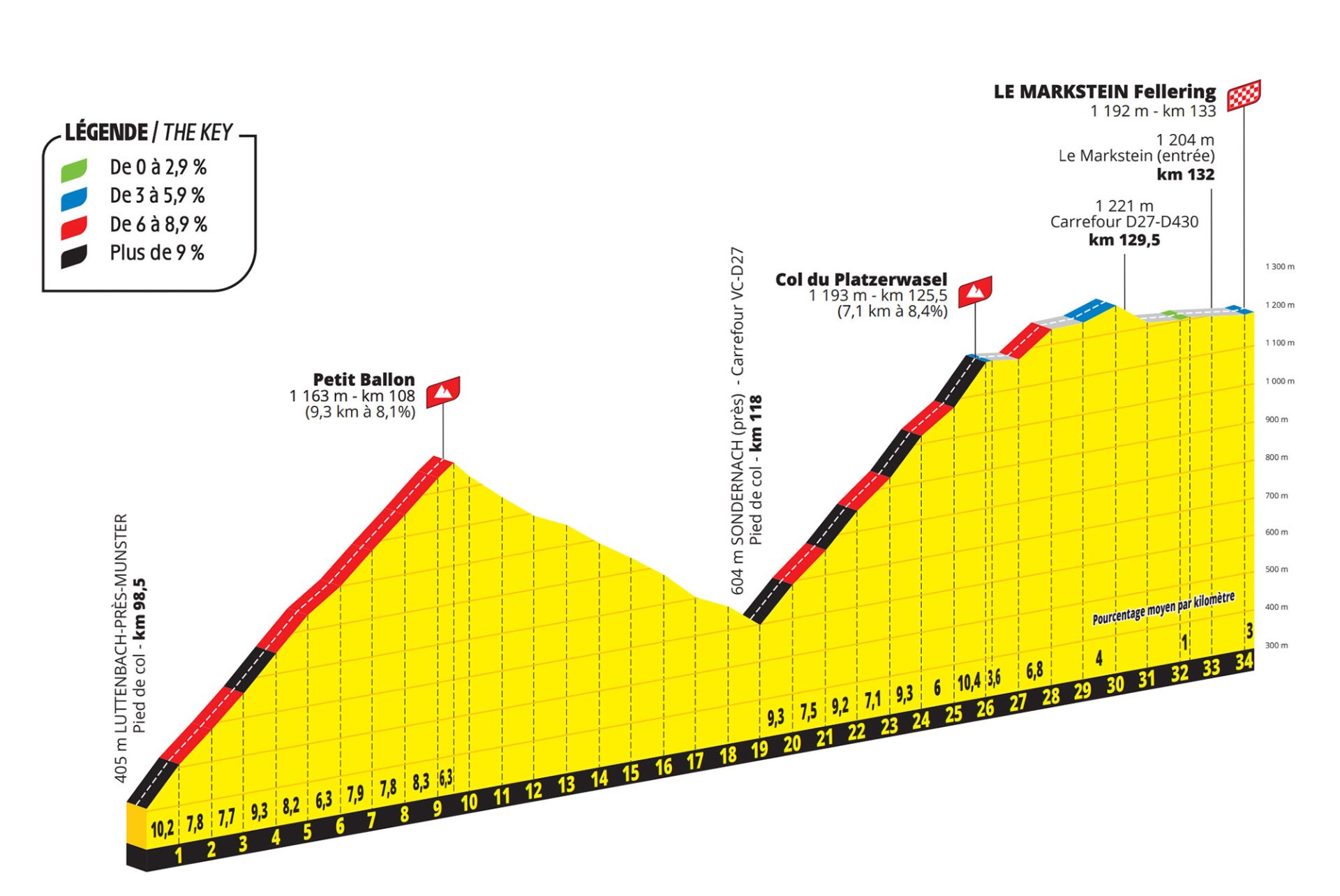

Le Markstein hosted the penultimate stage of last year’s Tour de France Femmes avec Zwift, where Annemiek van Vleuten took the race lead with a massive solo effort. That stage used the Petit Ballon/Platzerwasel combination earlier in the route.
The lack of flat roads on this route could lend it self to a long-range move. We can only hope.
Stage 21: Saint-Quentin-En-Yvelines to Paris Champs-Élysées – 115 km


Date: July 23, 2023
Stage type: Flat
Potential winners: Any sprinter left standing
What to watch for: Cavendish?
Stage summary: Ahh, Paris. We have arrived. The biggest sprint in the world, some post-race champagne, and we turn our attention to Clermont Ferrand, where the Tour de France Femmes has just kicked off.
What did you think of this story?
